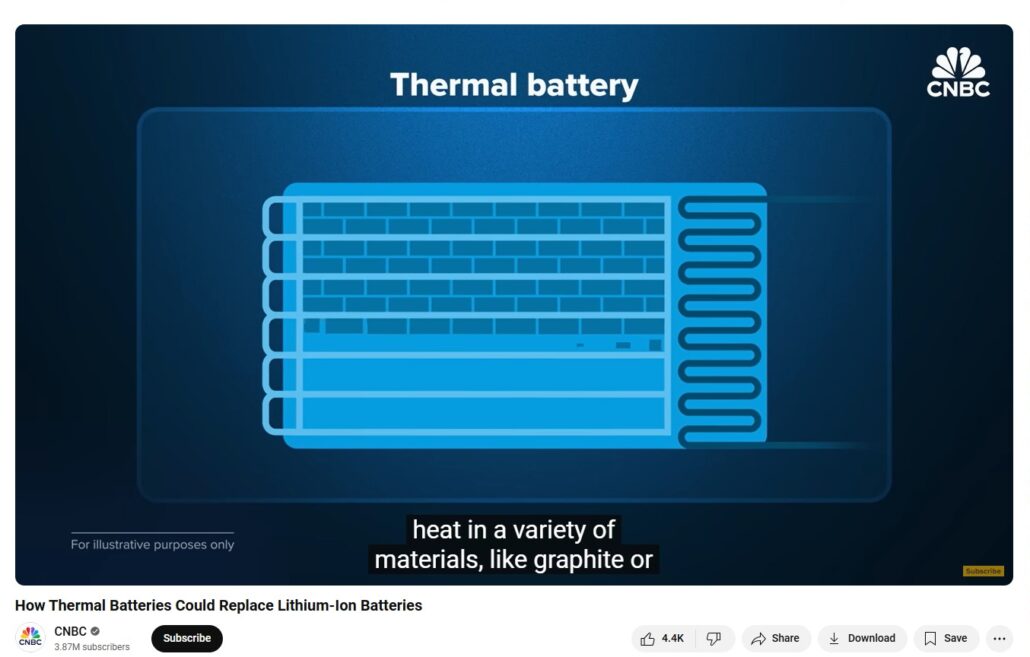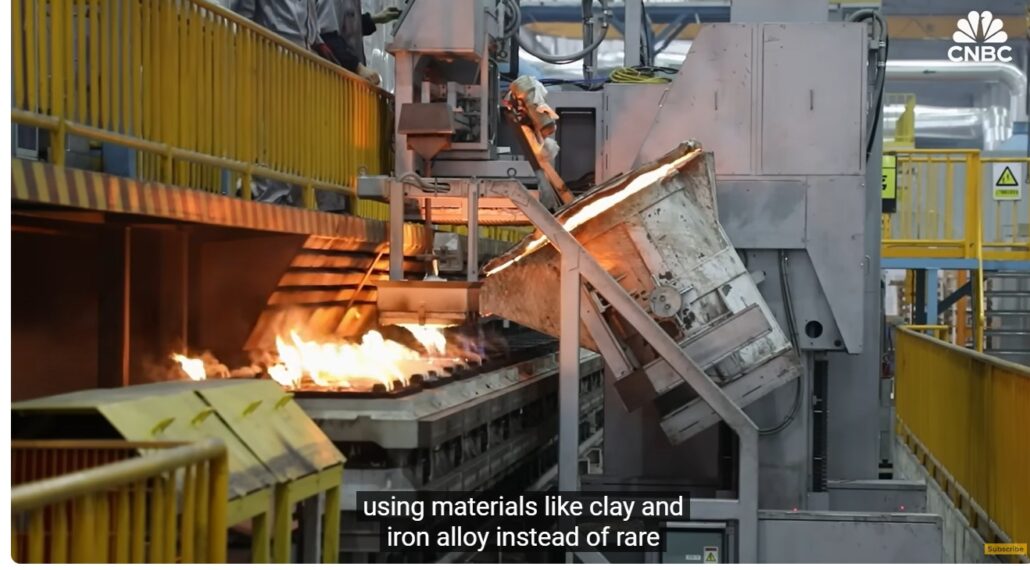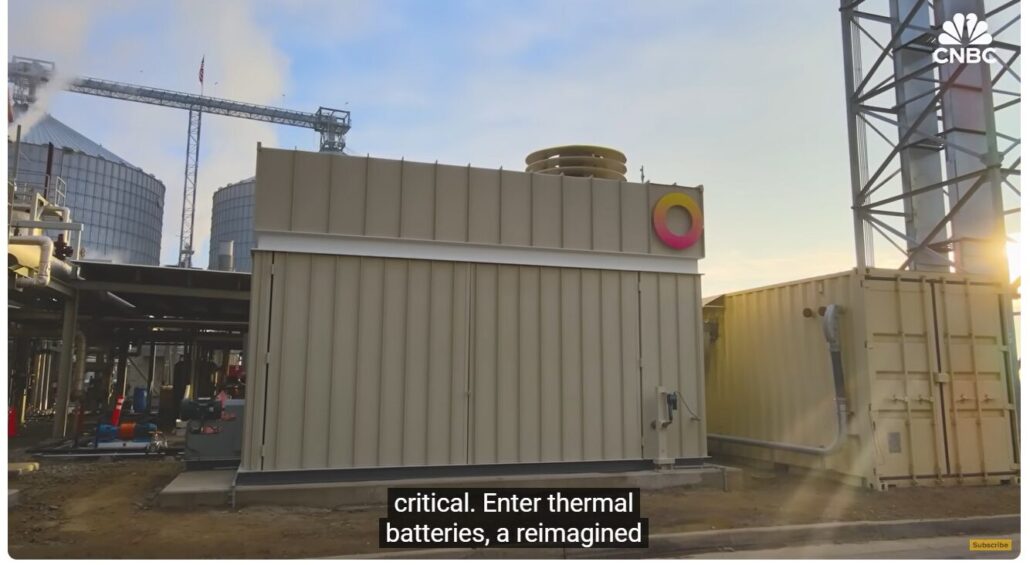Thermal battery technology is a method of storing energy in the form of heat for later use. Unlike electrochemical batteries that store chemical energy, thermal batteries utilize materials that can absorb and release thermal energy. This can be achieved through various means, such as:
- Sensible Heat Storage: Storing energy by changing the temperature of a material (solid or liquid) without a phase change. Common materials include water, oil, concrete, rocks, and sand. The amount of heat stored depends on the material’s mass, specific heat capacity, and the temperature difference.
- Phase Change Materials (PCMs): Storing energy through the heat absorbed or released when a material changes its physical state (e.g., solid to liquid, liquid to gas). PCMs can offer higher energy density compared to sensible heat storage within a narrower temperature range. Examples include salts, waxes, and other organic or inorganic materials.
- Thermochemical Storage: Storing energy in the form of reversible chemical reactions. When energy is input, an endothermic reaction occurs, and the products store the energy. Releasing the energy involves an exothermic reaction that reverses the process, releasing heat. This method can offer very high energy density and minimal heat loss over long periods.
How Thermal Batteries Work:
- Charging: Energy, often in the form of electricity (especially from renewable sources during off-peak hours or excess generation), is converted into heat. This can be done through resistive heating (like in a toaster), or by using heat pumps to transfer heat from one source to the storage medium. Industrial waste heat or solar thermal energy can also be directly stored
- Storage: The generated heat is stored in a thermally insulated medium. The choice of storage material depends on the desired temperature range, storage duration, and application. Insulation minimizes heat loss, allowing for storage from hours to even days or weeks.
- Discharge: When heat is needed, it is extracted from the storage medium. This can be done by circulating a heat transfer fluid (like air, water, or thermal oil) through the storage, which then carries the heat to the point of use. In some advanced systems, the stored heat can even be converted back into electricity using technologies like steam turbines or thermophotovoltaic cells.
Does Thermal Battery Technology Have a Future?
Yes, thermal battery technology has a significant and promising future due to several factors:
- Decarbonization of Industries: A substantial portion of global energy consumption goes towards industrial heating. Thermal batteries offer a cleaner alternative to fossil fuels for providing high-temperature heat for processes like food and beverage production, chemical manufacturing, steelmaking, and glassmaking. By storing electricity from renewable sources as heat, industries can reduce their carbon footprint and operational costs.
- Integration with Renewable Energy: Renewable energy sources like solar and wind are intermittent. Thermal batteries can store excess energy generated during peak production times and release it when needed, helping to stabilize the grid and improve the utilization of renewable resources. This reduces curtailment (wasted energy) and ensures a more reliable energy supply.
- Energy Efficiency and Cost Savings: Thermal batteries can utilize low-cost electricity during off-peak hours to charge, leading to significant cost savings compared to directly using electricity or burning fossil fuels for heating. They can also recover and reuse waste heat from industrial processes, further enhancing energy efficiency.
- Grid Flexibility and Stability: Thermal batteries can act as flexible loads on the grid, absorbing excess power when available and supplying it back as heat or electricity when demand is high. This helps to balance the grid, reduce congestion, and improve overall reliability.
- Abundant and Sustainable Materials: Compared to electrochemical batteries that rely on critical and often geographically concentrated materials like lithium and cobalt, thermal batteries can utilize more abundant and environmentally friendly materials such as rocks, sand, concrete, salts, and even biomaterials. This offers advantages in terms of cost, supply chain security, and ecological footprint.
- Diverse Applications: Beyond industrial heating and grid storage, thermal batteries have applications in:
- Building Heating and Cooling: Storing solar heat for nighttime heating or using stored cold for air conditioning, reducing reliance on conventional HVAC systems.
- Military and Aerospace: Powering critical systems in extreme environments due to their long shelf life, rapid activation, and high power density.
- Electric Vehicles (Future Potential): Research is exploring thermal batteries for rapid charging and extending the range of EVs.
Current Trends and Developments:
- Advanced Materials: Ongoing research focuses on developing new PCMs and sensible heat storage materials with higher energy density, better thermal conductivity, and long-term stability.
- System Design and Efficiency: Innovations in heat exchanger designs and insulation techniques are improving the efficiency of thermal battery systems.
- Integration with Smart Grids: Developing intelligent control systems to optimize the charging and discharging of thermal batteries based on grid conditions and energy prices.
-
- Scalability and Cost-Effectiveness: For large-scale energy storage, especially for industrial heating or grid-level applications, thermal batteries can be more cost-effective than electrochemical batteries. The materials used (like rocks, sand, concrete, or molten salts) are often cheaper and more readily available than the specialized materials required for large electrochemical battery packs. Scaling up the storage capacity often involves simply increasing the volume of the thermal storage medium and the size of the insulation.
- High Energy Density (Volumetric): Some thermal storage methods, particularly those using phase change materials (PCMs) or thermochemical storage, can achieve high energy density by volume. This means they can store a significant amount of energy in a relatively smaller space compared to sensible heat storage like water.
- Long Duration Storage: Thermal batteries, especially those utilizing well-insulated sensible heat storage or thermochemical reactions, can store energy for extended periods (hours, days, or even seasons) with minimal energy loss. This is crucial for applications like storing solar heat for nighttime use or industrial process heat for later shifts.
- High Power Output Potential: While the energy density by weight might not always be as high as some advanced electrochemical batteries, thermal batteries can deliver high power output by rapidly transferring the stored heat to the point of use (e.g., through heat exchangers).
- Safety and Lifespan: Thermal batteries generally have a longer lifespan and are often safer (less prone to thermal runaway or degradation) compared to some electrochemical battery technologies, especially for stationary large-scale applications.
- Pilot Projects and Commercialization: Several companies and research institutions are actively developing and deploying thermal battery technologies for various applications, indicating a move towards commercial viability.
Why Thermal Batteries Excel at Higher Size Energy Storage:
- Scalability and Cost-Effectiveness: For large-scale energy storage, especially for industrial heating or grid-level applications, thermal batteries can be more cost-effective than electrochemical batteries. The materials used (like rocks, sand, concrete, or molten salts) are often cheaper and more readily available than the specialized materials required for large electrochemical battery packs. Scaling up the storage capacity often involves simply increasing the volume of the thermal storage medium and the size of the insulation.
- High Energy Density (Volumetric): Some thermal storage methods, particularly those using phase change materials (PCMs) or thermochemical storage, can achieve high energy density by volume. This means they can store a significant amount of energy in a relatively smaller space compared to sensible heat storage like water.
- Long Duration Storage: Thermal batteries, especially those utilizing well-insulated sensible heat storage or thermochemical reactions, can store energy for extended periods (hours, days, or even seasons) with minimal energy loss. This is crucial for applications like storing solar heat for nighttime use or industrial process heat for later shifts.
- High Power Output Potential: While the energy density by weight might not always be as high as some advanced electrochemical batteries, thermal batteries can deliver high power output by rapidly transferring the stored heat to the point of use (e.g., through heat exchangers).
- Safety and Lifespan: Thermal batteries generally have a longer lifespan and are often safer (less prone to thermal runaway or degradation) compared to some electrochemical battery technologies, especially for stationary large-scale applications.
Thermal Batteries Are Less Ideal for Smaller Battery Storage Applications:
- Lower Energy Density (Gravimetric): For applications where weight and size are critical, such as portable electronics or electric vehicles, the energy density by weight of most thermal battery technologies is currently lower than that of electrochemical batteries like lithium-ion. The bulky insulation required to maintain temperature also adds to the overall weight and volume.
- Heat Losses: Maintaining high temperatures in a small, portable system with effective insulation can be challenging. Surface area to volume ratio is higher in smaller systems, leading to proportionally greater heat losses. This necessitates continuous energy input to maintain the desired temperature, reducing overall efficiency for small, isolated applications.
- Activation and Response Time: Some thermal battery technologies, particularly those relying on melting salts or initiating chemical reactions, might have a slower activation time compared to the instantaneous discharge of electrochemical batteries. This is less of an issue for large, stationary applications but can be a significant drawback for small, power-on-demand devices.
- Temperature Management Complexity: Precisely controlling and managing the temperature within a small thermal battery system can be complex and might require sophisticated control mechanisms, adding to the cost and complexity.
- Heat Transfer Limitations: Efficiently transferring heat into and out of a small thermal storage medium can be challenging. The design of effective heat exchangers at a small scale can be more complex and less efficient compared to larger systems.
- However, ongoing research and development in advanced materials and system designs might lead to more compact and efficient thermal battery solutions for some niche smaller-scale applications in the future. For instance, there might be specific scenarios where the long shelf life and wide operating temperature range of certain thermal battery types could be advantageous even in smaller sizes.
In conclusion, thermal battery technology presents a compelling solution for energy storage and heat management across various sectors. Its potential to decarbonize industries, enhance the integration of renewable energy, improve energy efficiency, and utilize sustainable materials positions it as a crucial technology for a cleaner and more resilient energy future.









